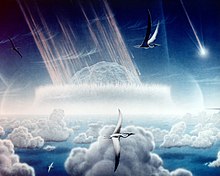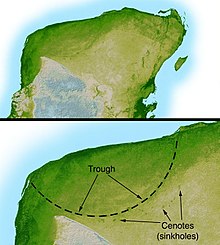Evidence[edit]
North American fossils[edit]
In North American terrestrial sequences, the extinction event is best represented by the marked discrepancy between the rich and relatively abundant late-Maastrichtian palynomorph record and the post-boundary fern spike.[53]
At present the most informative sequence of dinosaur-bearing rocks in the world from the K–Pg boundary is found in western North America, particularly the late Maastrichtian-age Hell Creek Formation of Montana, US. This formation, when compared with the older (approximately 75 Ma) Judith River/Dinosaur Park Formations (from Montana, USA, and Alberta, Canada, respectively) provides information on the changes in dinosaur populations over the last 10 million years of the Cretaceous. These fossil beds are geographically limited, covering only part of one continent.[79]
The middle–late Campanian formations show a greater diversity of dinosaurs than any other single group of rocks. The late Maastrichtian rocks contain the largest members of several major clades: Tyrannosaurus,Ankylosaurus, Pachycephalosaurus, Triceratops and Torosaurus,[92] which suggests food was plentiful immediately prior to the extinction.
In addition to rich dinosaur fossils, there are also plant fossils that illustrate the reduction in plant species across the K–Pg boundary. In the sediments below the K–Pg boundary the dominant plant remains areangiosperm pollen grains, but the actual boundary layer contains little pollen and is dominated by fern spores.[93] More usual pollen levels gradually resume above the boundary layer. This is reminiscent of areas blighted by modern volcanic eruptions, where the recovery is led by ferns, which are later replaced by larger angiosperm plants.[94]
Marine fossils[edit]
The mass extinction of marine plankton appears to have been abrupt and right at the K–Pg boundary.[95] Ammonite genera became extinct at or near the K–Pg boundary; however, there was a smaller and slower extinction of ammonite genera prior to the boundary that was associated with a late Cretaceous marine regression. The gradual extinction of most inoceramid bivalves began well before the K–Pg boundary, and a small, gradual reduction in ammonite diversity occurred throughout the very late Cretaceous.[96] Further analysis shows that several processes were in progress in the late Cretaceous seas and partially overlapped in time, then ended with the abrupt mass extinction.[96]
Megatsunamis[edit]
The scientific consensus is that bolide impact at the K–Pg boundary left tsunami deposits and sediments around the area of the Caribbean Sea and Gulf of Mexico.[97] These deposits have been identified in the La Popa basin in northeastern Mexico,[98] platform carbonates in northeastern Brazil,[99] and Atlantic deep-sea sediments.[100]
Duration[edit]
The length of time taken for the extinction to occur is a controversial issue, because some theories about the extinction's causes require a rapid extinction over a relatively short period (from a few years to a few thousand years) while others require longer periods. The issue is difficult to resolve because of the Signor–Lipps effect; that is, the fossil record is so incomplete that most extinct species probably died out long after the most recent fossil that has been found.[101] Scientists have also found very few continuous beds of fossil-bearing rock which cover a time range from several million years before the K–Pg extinction to a few million years after it.[23]
Chicxulub asteroid impact[edit]
Evidence for impact[edit]
In 1980, a team of researchers consisting of Nobel prize-winning physicist Luis Alvarez, his son geologist Walter Alvarez, and chemists Frank Asaro and Helen Micheldiscovered that sedimentary layers found all over the world at the Cretaceous–Paleogene boundary contain a concentration of iridium many times greater than normal (30, 160 and 20 times in three sections originally studied). Iridium is extremely rare in Earth's crust because it is a siderophile element, and therefore most of it travelled with the iron as it sank into Earth's core during planetary differentiation. As iridium remains abundant in most asteroids and comets, the Alvarez team suggested that an asteroid struck the Earth at the time of the K–Pg boundary.[4] There were earlier speculations on the possibility of an impact event, but this was the first hard evidence of an impact.[102]
This hypothesis was viewed as radical when first proposed, but additional evidence soon emerged. The boundary clay was found to be full of minute spherules of rock, crystallized from droplets of molten rock formed by the impact.[103] Shocked quartz and other minerals were also identified in the K–Pg boundary.[104][105] Shocked minerals have their internal structure deformed, and are created by intense pressures such as those associated with nuclear blasts or meteorite impacts. The identification of gianttsunami beds along the Gulf Coast and the Caribbean also provided evidence for impact,[106] and suggested that the impact may have occurred nearby—as did the discovery that the K–Pg boundary became thicker in the southern United States, with meter-thick beds of debris occurring in northern New Mexico.[13]
K/T impact site on a contemporary world map (65 mya)[107]
Further research identified the giant Chicxulub crater, buried under Chicxulub on the coast of Yucatán, Mexico as the source of the K–Pg boundary clay. Identified in 1990[6]based on work by geophysicist Glen Penfield in 1978, the crater is oval, with an average diameter of roughly 180 kilometres (110 mi), about the size calculated by the Alvarez team.[108] The discovery of the crater – a necessary prediction of the impact hypothesis – provided conclusive evidence for a K–Pg impact, and strengthened the hypothesis that the extinction was caused by an impact.
In 2007, a hypothesis was put forth that argued the impactor that killed the dinosaurs belonged to the Baptistina family of asteroids.[109] Concerns have been raised regarding the reputed link, in part because very few solid observational constraints exist of the asteroid or family.[110] Indeed, it was recently discovered that 298 Baptistina does not share the same chemical signature as the source of the K–Pg impact.[111] Although this finding may make the link between the Baptistina family and K–Pg impactor more difficult to substantiate, it does not preclude the possibility.[111] A 2011 WISE study of reflected light from the asteroids of the family estimated the break-up at 80 Ma, giving it insufficient time to shift orbits and impact the Earth by 66 Ma.[112]
Paul Renne of the Berkeley Geochronology Center has reported that the date of the asteroid event is 66.043±0.011 million years ago, based on argon–argon dating. He further posits that the mass extinction occurred within 33,000 years of this date.[2][113]




No comments:
Post a Comment